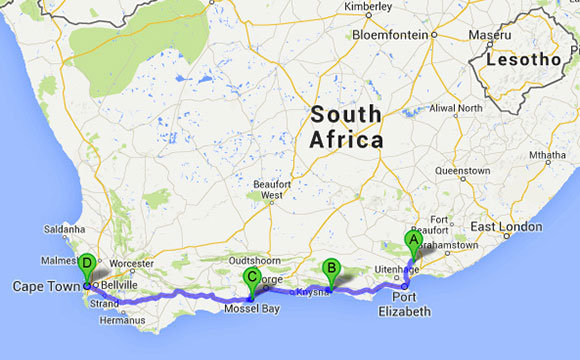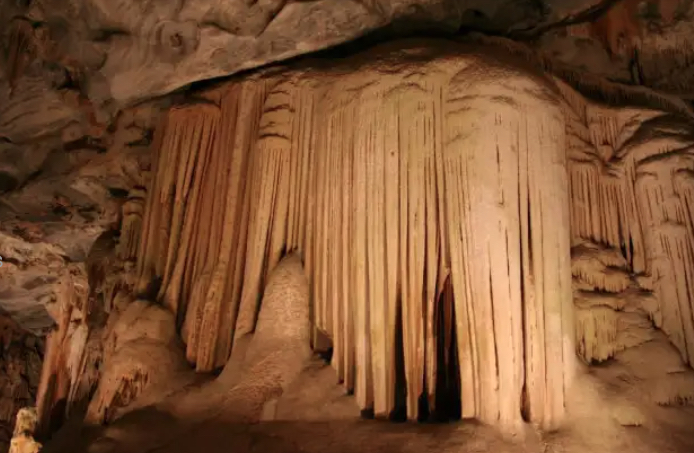
122. The Garden Route
Having lived most of my life in one of the most beautiful countries in the world, I have often wondered what I would rate as the most scenic place in South Africa. Arguably, Cape Town rates as the most beautiful city on Earth but there’s a 200-kilometer stretch of coastline that encompasses a breathtaking range of varying vistas that I would claim is the most complete expression of Africa’s grandeur in a relatively compact region: the Garden Route!

Nobody seems to know why it is so named. It has an incredible selection of lakes, mountains, wetlands, woodlands, and long white beaches with a huge variety of vegetation and wildlife. Not exactly an English country garden!
My first sight of this glorious region was in 1947, when my parents and I had driven from Durban in the province of Natal on the east coast in a 1928 Plymouth sports coupe to settle in Cape Town. It was a wonderful old car but, as a two-seater, I was relegated to the “Dickie seat” that took the place of the boot (or trunk in the US). A seat opened up exposed to the elements as we drove nearly all the way on dirt roads, sometimes choking with dust or (on other occasions) soaking from torrential rain.
Nevertheless, I loved every minute of the drive after we left the city of Port Elizabeth and entered the Garden Route after crossing Storms River and wound up and down the old mountain pass through the indigenous Tsitsikamma forest. We had glimpses of the ocean in the distance and hordes of monkeys frolicking amongst the trees’ vines and exotic blossoms. For a ten-year-old English kid, having lived through the uncertainties of World War II and the privations of food rationing, I was in awe of the terrain. The forest eventually gave way to rolling hills, golden beaches interspersed with rugged coastlines, lakes and lagoons festooned with pelicans and flamingos. We passed the little town of Plettenberg Bay, fast becoming a major tourism venue, and on to the older, more picturesque town of Knysna where we stopped the night. Pop was excited when booking into the hotel to see that the name in the register before him was an Ivan C. Dresser from the United States.
They met that evening and there was a definite probability that Ivan was related to our Dresser family tree going back to 1352 when the first Christopher Dresser, a Danish sea captain, had settled in Yorkshire. Ivan was the president of General Motors Overseas Corporation and had been visiting the General Motors assembly plant in Port Elizabeth. He and Pop corresponded for some years but never met again.
We drove on towards Cape Town the following day and entered George, the largest town on the Garden Route, a few minutes after the train carrying King George VI and the Royal family arrived there on their tour of South Africa. The irony of the large banner hoisted above the railway station which read “Welcome to George” did not escape us.
We finally reached Cape Town where we settled for some years before Pop unexpectedly bought a pilchard fishing trawler in the west coast port of Walvis Bay surrounded by the Namib desert. Mop, as I now called my mother, remained in Cape Town until I completed my schooling at Michaelhouse in Natal outside Durban. She then joined Pop shortly before I arrived there at the end of 1954.
Apart from a brief holiday in Knysna with a school friend and his family, I did not get a chance to visit the Garden Route again until I was working at Killarney Film Studios in 1966. The studio was considering making a picture about circus life. Boswell Circus, for many years the largest circus in South Africa, was touring the Western Cape. I was to join them for a week in the little fishing port of Mossel Bay at the southern end of the Garden Route and come back with a storyline to be developed as a screenplay. I was excited both by the prospect of visiting the area again and, more particularly, the possibility of writing a feature film screenplay.
In the event, I saw very little of the Garden Route on that trip. I was plunged into the daily life of the circus community and devoted my time to getting to know some of the larger-than-life characters that populated their tented world. These ranged from “Tickey” the dwarf clown to the morose lion tamer and the trapeze act consisting of two young men and an incredibly beautiful young girl married to one of the trapezists. I later was surprised to learn that most of the trapeze acts in circuses around the world were to be South African groups, starting with the Flying Oslers in 1967. Of the original group, Freddy Osler would continue to dominate trapeze work in Europe until retiring to New Zealand with his wife a decade or so later.
Keith Anderson, another of the Flying Oslers, returned to South Africa where he concentrated on training young flyers on a rig set up on the slopes of Table Mountain. I spent most of my time chatting with Tickey, a wonderful character, as he regaled me with tales of circus life. The young girl clearly needed someone to confide in. She told me of her discovery that her husband and trapeze partner was, in fact gay. She loved her trapeze career yet felt trapped by her need to continue the circus act but burdened by an increasingly loveless marriage. The lion tamer also had some tragic tales to tell; and even Tickey, who made everyone laugh, was like so many comedians constantly suffering fits of depression. The management team took it upon themselves to try to keep their troubled performers happy and content with their work, which they succeeded in doing to a certain extent. My week with these folks revealed a small and tight-knit community, emotionally troubled but fanatically attached to their circus world.
My last couple of days with them was spent observing the incredible speed with which the huge circus tent was taken down and stored aboard the train to take them to Swellendam, their next destination. I went on the train with them to their new site. I left feeling that I had more than enough material to write a powerful screenplay about circus life. As so often happened in those early years, I returned to Johannesburg to be told that the studios had decided not to proceed with making a circus movie – and I never got to write the screenplay.
It just so happened that a short while later, a rival movie company asked me to read a circus screenplay and offer my opinion. I read it with growing horror and told the producer, Elmo de Wit, that I could only describe it as a load of crap. I feared he would think it was me having an attack of sour grapes, but he laughed and said, “You’re right but you’re not gonna believe who wrote it!”
I admitted that I had no idea. To my amazement the name of the screenwriter was someone whom I admired enormously as a novel writer – Wilbur Smith! I regarded Wilbur as one of the finest adventure novelists in the world at that time and his descriptions of places and people in Africa were superb. This had nothing to do with my technically having been at school with him. I say technically because he was one of the gods of the 6th Form when I was in my humble first year at Michaelhouse, arguably one of the top private schools in the country. Many years later I spoke to Wilbur at one of his book signings in London and carefully mentioned the circus screenplay. He laughed and replied, “It was a lot of crap. I learned to stick with novel writing after that.” I was delighted with his honest appraisal of the screenplay and my admiration for him as a writer went up another notch.
All of which has done little for my love of the Garden Route. In later years as my four kids were growing up, Hero and I made certain that, regardless of our finances and any other barriers, we would always spend our Christmas holidays at the coast in the fine southern hemisphere tradition of a sunny “swimmy”’ Christmas. More often than not, we would find our way to the Garden Route, staying with friends who had a wonderful estate just within the Knysna forest, or renting a house in George. Victoria Bay, close to the town, offers excellent swimming and surfing opportunities. Lakes, and lagoons offer a mix of watersports or quiet contemplative fishing from small boats or along the shoreline. Snorkeling and scuba diving is popular in the Sedgefield area. Hikes into the adjoining Knysna/Tsitsikamma forests reveal the amazing variety of flora and fauna in southern Africa’s largest indigenous forests. I believe that only one of the fabled Knysna elephants still survives, which is very sad. As written in an earlier blog, my film crew and I were nearly trampled by Adam the great elephant bull when nine of these magnificent creatures still roamed the forest. There were believed to be over 3,000 elephants in the region before man began his senseless hunting and killing of the pachyderms. Today, the nearby Addo Elephant Park has restored a sizable herd that is protected by the National Parks Board and worth a visit.
Another place to visit on the periphery of the Garden Route is Outdshoorn, on the other side of the spectacular Outeniqua mountain pass. It was once the world center of a massive ostrich feather industry in the 1800s – before the early open motor cars swept the feather plumed hats off the heads of the elegant ladies of London and Paris. Today, ostriches are still bred for their eggs and their tasty meat. If you have the courage, take a ride on an ostrich. It’s tricky but great fun. Outside of Outdshoorn are the world-famous Cango Caves where choirs and concerts are sometimes held in their massive and magical caverns.

To sum up, the Garden Route is a microcosm of all the diversity that South Africa has to offer. My kids, now in their fifties, have never forgotten their adventurous childhood holidays in that region. I’m hoping that soon they will all join me in a fantastic new adventure as the first working model of ExoTech’s ground-breaking computing system replaces confused complexity with the serene simplicity of real human-type communication!

